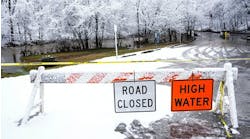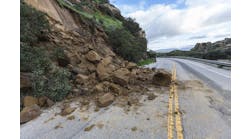By: Paul Melander
Many people remember exactly where they were when they heard about the attacks on the U.S. on Sept. 11, 2001. Countless lives were affected by the loss of loved ones, injuries and loss of jobs. Even our economy suffered as part of the consequences of this terrorist attack. Our lives have changed as our government has wrestled with how to best protect our freedom and us. As a result, the transportation sector also has been affected.
One of the first changes implemented after the Sept. 11 attacks was the U.S. Patriot Act. This act required the transportation sectors of the U.S. Department of Transportation (U.S. DOT) to evaluate the safety and security risks within our transportation infrastructure. The U.S. DOT focused on airline safety and the transportation of hazardous materials first and foremost. Congress was concerned that theft, hijacking or even a covert employee could divert hazardous material to terrorists. Consequently, the Patriot Act required the U.S. DOT to conduct background checks on everyone with a Hazardous Materials Endorsement (HME) on their Commercial Driver’s License (CDL). The U.S. DOT also is required to keep fingerprint records on these drivers. The Patriot Act also listed new eligibility requirements to hold an HME.
Later, Congress approved establishment of the Department of Homeland Security (DHS). The security responsibilities of the U.S. DOT and the U.S. Coast Guard were transferred to the DHS. Both the U.S. DOT and the DHS continued to research and explore new ways to make our transportation infrastructure safe and secure.
Money to fight
The DHS has many grant programs to help train and equip emergency-response personnel in the event of a terrorist attack. Examples of these grants include: First Responder Grants: The objective of this grant is to enhance the capacity of state and local first responders to respond to weapons of mass destruction (WMD) terrorist attacks involving chemical, biological, radiological, nuclear or explosive devices. Funds will be used to provide support for planning and conducting exercises at the national, state and local levels.Training Grants: This grant was created to enhance the capacity of state and local first responders to react to a WMD terrorism incident involving chemical, biological, radiological, nuclear or explosive devices.
Highway Watch Grant: The purpose of the Highway Watch Program is to promote security awareness among all segments of the commercial motor carriers and transportation community. The Highway Watch Program plans to train the nation’s commercial drivers to observe and report any suspicious activities or items that may threaten critical elements of the nation’s highway transportation system.
The watch list
The DHS in cooperation with the private sector has established the Highway Watch, the Port Watch and the Transit Watch. These programs use the labor pool of each mode of transportation to identify suspicious activity. All volunteers receive training on what to look for and how to report suspicious activities. Once trained, the volunteers are assigned a unique number that identifies them as a trained observer and a toll-free number to a call center that receives, analyzes and disperses the information to federal, state and local agencies.Highway Watch reports are combined with other information sources and shared both with federal agencies and the roadway transportation sector by the Highway Information Sharing and Analysis Center. Highway Watch is administered by the American Trucking Associations under a cooperative agreement with the DHS. All roadway transportation sector professionals are welcome to join Highway Watch. Training is provided free of charge by transportation sector volunteer instructors. For more information, you may go to www.highwaywatch.com.
Close watch
The Transportation Security Administration (TSA) began the third and final implementation phase of the Hazardous Materials Threat Assessment Program on May 31, 2005, with the fingerprinting of commercial truck drivers applying to renew or transfer the HME on their state-issued CDL.During phase one, TSA conducted name-based security threat assessments on all 2.7 million licensed hazardous materials drivers to determine whether any presented a potential terrorist threat. Phase two augmented this effort by adding a fingerprint-based Federal Bureau of Investigation (FBI) criminal history records check and immigration status check for new HME applicants. This third and final phase will require drivers seeking to renew or transfer their current HME to undergo the fingerprint-based security threat assessment.
Newly established procedures require every applicant for the HME on their CDL to take the required knowledge test and submit themselves for fingerprinting. These fingerprints are transmitted to the TSA of the DHS for analysis. Once the fingerprints and the driver have passed this review, the TSA notifies the state to approve the applicant. This process takes about 90 days.
Those who already have the HME must re-apply for their CDL no earlier than 60 days from expiration and no later than 30 days from expiration in order to keep the endorsement pending the analysis of their fingerprints. The cost of the fingerprinting is roughly $90 in addition to the licensing and endorsement fee. To find a listing of the fingerprinting locations in your state or for further information about the program, go to www.hazprints.com.
Permit passing
The U.S. DOT established rules that require shippers and transporters of hazardous materials to conduct an evaluation of their vulnerabilities and to address them with a security plan. This plan must address personnel security, unauthorized access to the hazardous materials and en-route security. The hazardous materials employee must be trained concerning the elements of the plan and how the plan is implemented. The security training must include the company’s security objectives, specific security procedures, employee responsibilities, actions to take in the event of a security breach and the company’s security structure. The U.S. DOT offers help with how to develop a security plan at hazmat.dot.gov.On Jan. 1, 2005, the Federal Motor Carrier Safety Administration (FMCSA) began the Federal Hazardous Materials Safety Permit Program for intrastate, interstate and foreign motor carriers transporting certain types and amounts of hazardous materials. These carriers must maintain a certain level of safety in their operations and certify they have programs in place as required by the Hazardous Materials Regulations and the Hazardous Materials Permit Regulations.
The following hazardous materials require a Hazardous Materials Safety Permit when transported in the specified quantities:
Radioactive Materials: A highway route-controlled quantity of Class 7 material, as defined in §173.403 of 49 CFR;
Explosives: More than 55 lb of a Division 1.1, 1.2 or 1.3 material or an amount of a Division 1.5 material requiring a placard under Part 172 Subpart F of 49 CFR; Toxic by Inhalation Materials—Hazard Zone A: More than one liter per package of a “material poisonous by inhalation,” as defined in § 171.8 of 49 CFR, that meets the criteria for “Hazard Zone A,” as specified in § 173.116(a) or § 173.133(a) of 49 CFR; Hazard Zone B: A “material poisonous by inhalation,” as defined in § 171.8 of 49 CFR, that meets the criteria for “Hazard Zone B,” as specified in § 173.116(a) or § 173.133(a) of 49 CFR in a bulk packaging (capacity greater than 119 gal for liquids and a water capacity greater than 1,000 lb for gas receptacles);
Hazard Zone C & D: A “material poisonous by inhalation,” as defined in § 171.8 of 49 CFR, that meets the criteria for “Hazard Zone C” or “Hazard Zone D,” as specified in § 173.116(a) or § 173.133(a) of 49 CFR, in a packaging having a capacity equal to or greater than 3,500 gal; and
Methane: A shipment of compressed or refrigerated liquid methane or liquefied natural gas or other liquefied gas with a methane content of at least 85% in a bulk packaging having a capacity equal to or greater than 3,500 gal for liquids or gases.
In order to earn this permit, motor carriers are required to:
- Maintain a “satisfactory” safety rating in order to obtain and hold a Hazardous Materials Safety Permit;
- Maintain their crash rating and their vehicle, hazardous material or out-of-service rate so as to not be in the worst 30% of the national average as indicated in the Motor Carrier Management Information System;
- Have a satisfactory security program (and associated training) according to 49 CFR § 172.800. Maintain hazardous materials registration with the Research and Special Programs Administration;
- Develop a system of communication that will enable the driver to contact the motor carrier during the course of transportation and maintain records of these communications;
- Have a written route plan for radioactive materials in 49 CFR § 397.101 and for explosives in 49 CFR § 397.19; and
- Perform a pre-trip inspection (North American Standard Level VI Inspection Program for Radioactive Shipments) for shipments containing highway route controlled Class 7 (radioactive) materials.
Motor carriers that violate permit requirements may have their Hazardous Materials Safety Permit suspended or revoked. There is a process for appealing decisions to suspend or revoke a Hazardous Materials Safety Permit. New and existing motor carriers are required to submit an MCS-150B form to start the Hazardous Materials Permit application process. New interstate hazardous materials carriers applying for a DOT number and a Hazardous Materials Safety Permit also are required to submit an MCS-150A (Safety Certification Application) form. All forms are on FMCSA’s website, (usdotnumberregistration.com), and may be submitted online or may be obtained by calling 800/832-5660.
In addition to the new requirements mentioned above, members of Congress are routinely submitting proposed legislation that affects hazardous material transportation. Ideas such as pre-notifying all law enforcement and fire agencies before hazardous materials are transported, removing the requirement for placarding vehicles and requiring satellite tracking of all hazardous material shipments continue to be investigated. Look for further requirements such as the Transportation Workers Identity Card in the future.
Yes, the world has changed since Sept. 11, especially for us in the transportation industry. Stay informed and let your elected representatives and government agencies know how their proposals will affect your business. Do your part to ensure that the government hears your concerns and ideas to provide a safe, secure and efficient transportation system for all.
About The Author: Melander is the director of safety for Tennessee Express Inc., Nashville, Tenn.


